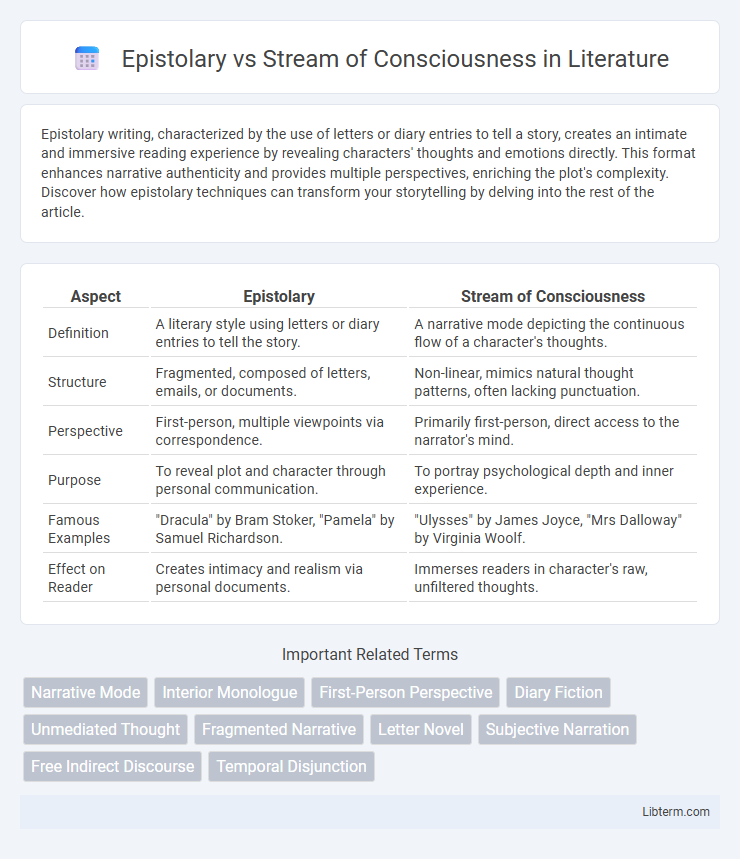Epistolary writing, characterized by the use of letters or diary entries to tell a story, creates an intimate and immersive reading experience by revealing characters' thoughts and emotions directly. This format enhances narrative authenticity and provides multiple perspectives, enriching the plot's complexity. Discover how epistolary techniques can transform your storytelling by delving into the rest of the article.
Table of Comparison
| Aspect | Epistolary | Stream of Consciousness |
|---|---|---|
| Definition | A literary style using letters or diary entries to tell the story. | A narrative mode depicting the continuous flow of a character's thoughts. |
| Structure | Fragmented, composed of letters, emails, or documents. | Non-linear, mimics natural thought patterns, often lacking punctuation. |
| Perspective | First-person, multiple viewpoints via correspondence. | Primarily first-person, direct access to the narrator's mind. |
| Purpose | To reveal plot and character through personal communication. | To portray psychological depth and inner experience. |
| Famous Examples | "Dracula" by Bram Stoker, "Pamela" by Samuel Richardson. | "Ulysses" by James Joyce, "Mrs Dalloway" by Virginia Woolf. |
| Effect on Reader | Creates intimacy and realism via personal documents. | Immerses readers in character's raw, unfiltered thoughts. |
Introduction to Epistolary and Stream of Consciousness
Epistolary narratives unfold through letters, diary entries, or other personal documents, immersing readers in characters' perspectives by providing intimate and direct communication. Stream of consciousness captures the continuous, often chaotic flow of a character's thoughts and feelings, presenting an unfiltered inner experience. Both techniques offer unique insights into character psychology but differ in structure and immediacy.
Defining the Epistolary Narrative
The epistolary narrative is a storytelling technique that unfolds through a series of letters, diary entries, or other personal documents, providing intimate insights into characters' thoughts and emotions. This format allows readers to experience the plot from multiple perspectives, emphasizing personal voice and subjective truth. Distinguished from stream of consciousness, the epistolary narrative maintains structured communication, often revealing plot developments through written correspondence rather than unfiltered mental flow.
Understanding Stream of Consciousness Technique
Stream of consciousness technique presents characters' thoughts and feelings in a continuous flow, often fragmented and nonlinear, mimicking natural cognition. Unlike the epistolary form, which conveys narrative through letters or documents, stream of consciousness immerses readers directly into the mental processes, revealing subconscious associations and emotional nuances. Pioneered by writers like James Joyce and Virginia Woolf, this style emphasizes inner experience over external action, enhancing psychological depth and realism.
Historical Origins and Literary Evolution
Epistolary narrative style, emerging prominently in the 17th century with works like Samuel Richardson's "Pamela," utilizes letters to provide intimate insights and fragmented viewpoints, influencing personal and emotional reader engagement. Stream of consciousness evolved in the early 20th century, pioneered by authors such as James Joyce in "Ulysses" and Virginia Woolf in "Mrs Dalloway," aiming to depict the continuous flow of a character's mental processes for psychological depth. Both techniques revolutionized literary forms by emphasizing subjective experience, with epistolary focusing on external correspondence and stream of consciousness delving into internal cognition.
Key Characteristics of Epistolary Writing
Epistolary writing is characterized by its use of letters, diary entries, or other personal documents to convey the narrative, creating an intimate and direct voice from the characters. This format allows readers to experience multiple perspectives through first-person accounts, enhancing emotional depth and authenticity. The structure naturally introduces gaps and biases, requiring readers to piece together the story from subjective fragments.
Hallmarks of Stream of Consciousness Narration
Stream of consciousness narration is characterized by a continuous flow of a character's thoughts, feelings, and sensory experiences, often presented in an unstructured or fragmented manner. This technique captures the inner workings of the mind through interior monologues, free association, and nonlinear progression, reflecting the complexity of human consciousness. Writers like James Joyce and Virginia Woolf exemplify this style by using varied punctuation, syntax, and shifts in perspective to immerse readers in a character's psychological landscape.
Notable Examples in Literature
Epistolary novels like *Dracula* by Bram Stoker and *The Color Purple* by Alice Walker utilize letters or diary entries to reveal characters' internal thoughts and advance the plot through personal correspondence. Stream of consciousness is exemplified in works such as James Joyce's *Ulysses* and Virginia Woolf's *Mrs. Dalloway*, where the narrative flow mimics the protagonist's continuous inner monologue and fragmented thought processes. These distinct narrative techniques provide deep psychological insight and immerse readers in the subjective experiences of characters.
Reader Experience and Emotional Impact
Epistolary narratives immerse readers through intimate, firsthand correspondence, creating a personal and direct emotional connection by revealing characters' thoughts and feelings explicitly. Stream of consciousness offers a raw, unfiltered flow of characters' inner experiences, engaging readers with a deeper psychological complexity and nuanced emotional landscape. The epistolary form often feels more accessible and relatable, while stream of consciousness challenges readers to navigate fragmented thoughts, intensifying the emotional depth and empathetic response.
Strengths and Limitations of Each Style
Epistolary style excels in providing intimate, personal perspectives through letters or diary entries, enabling readers to witness character development and emotional depth directly; however, it can limit narrative scope and slow pacing due to its fragmented structure. Stream of consciousness captures the raw, unfiltered flow of a character's thoughts, offering deep psychological insight and immersive realism, but may challenge readers with its nonlinear, often chaotic syntax and lack of clear plot direction. Both styles demand careful balance to maintain clarity while maximizing their unique strengths in conveying inner experiences.
Choosing Between Epistolary and Stream of Consciousness
Choosing between epistolary and stream of consciousness writing depends on the desired narrative structure and character insight. Epistolary form uses letters, diary entries, or emails, providing intimate, fragmented perspectives that reveal plot through documented communication. Stream of consciousness offers a continuous flow of a character's thoughts and feelings, immersing readers deeply into their psychological experience and internal conflicts.
Epistolary Infographic

 libterm.com
libterm.com